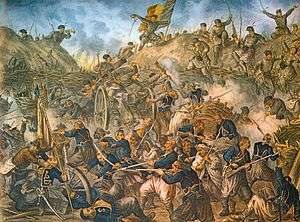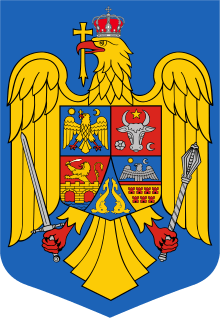Romanian War of Independence
The Romanian War of Independence is the name used in Romanian historiography to refer to the Russo-Turkish War (1877–78), following which Romania, fighting on the Russian side, gained independence from the Ottoman Empire. On April 16 [O.S. April 4] 1877, Romania and the Russian Empire signed a treaty at Bucharest under which Russian troops were allowed to pass through Romanian territory, with the condition that Russia respected the integrity of Romania. The mobilization began, and about 120,000 soldiers were massed in the south of the country to defend against an eventual attack of the Ottoman forces from south of the Danube. On April 24 [O.S. April 12] 1877, Russia declared war on the Ottoman Empire and its troops entered Romania through the newly built Eiffel Bridge.
Background
On May 21 [O.S. May 9] 1877, in the Romanian parliament, Mihail Kogălniceanu read the act of independence of Romania as the will of the Romanian people. A day later, on May 22 [O.S. May 10] 1877, the act was signed by Prince Carol I, officially declaring the full state independence. The Romanian government immediately canceled paying tribute to Turkey (914,000 lei), and the sum was given instead to the War Ministry.
Initially, before 1877, Russia did not wish to cooperate with Romania, since they did not wish Romania to participate in the peace treaties after the war, but the Russians encountered a very strong Turkish army of 40,000 soldiers led by Osman Pasha at the Siege of Plevna (Pleven) where the Russian troops led by Russian generals suffered very heavy losses and were routed in several battles.[10]
War
Due to great losses, Grand Duke Nikolai Nikolaevich, the Russian commander-in-chief, asked Prince Carol I for the Romanian Army to intervene and join forces with the Russian Army.[10][11]
Prince Carol I accepted the Duke's proposal to become the Marshal of the Russian troops in addition to the Command of his own Romanian army, thus being able to lead the combined armed forces to the conquest of Plevna and the formal surrender, after heavy fighting, of the Turkish General Osman Pasha. The Romanian Army won the battles of Grivitsa and Rahova, and on 28 November 1877 the Plevna citadel capitulated, and Osman Pasha surrendered the city, the garrison and his sword to the Romanian colonel Mihail Cerchez. After the occupation of Plevna, the Romanian Army returned to the Danube and won the battles of Vidin and Smârdan.
On 19 January 1878, the Ottoman Empire requested an armistice, which was accepted by Russia and Romania. Romania won the war but at a cost of more than 10,000 casualties. Its independence from the Porte was finally recognised by the Central Powers on 13 July 1878.
.jpg)

Naval operations

The Romanian Navy consisted of three gunboats: Ştefan cel Mare, România and Fulgerul and one spar torpedo boat, Rândunica.[12] The three gunboats displaced 352, 130 and 85 tons respectively.[13] Ştefan cel Mare and România were each armed with four guns and Fulgerul with one gun.[14] Despite its inferiority on paper, the Romanian Navy destroyed many Turkish river gunboats.[15] The lightly armored Romanian spar torpedo boat Rândunica, with a displacement of 9 tons[16] and commanded by Major Ioan Murgescu,[17] attacked and sank the Ottoman river monitor Seyfi near Măcin, a success that brought clients from all over the world to her British builders.[18] This was also the first instance in history when a torpedo craft sank its target without also sinking.[19] Another river monitor, the Podgoriçe, was shelled and sunk by Romanian coastal artillery on 7 November 1877.[20]
After being refitted and modernized at the Galați shipyard in 1900 and having her displacement increased to 10 tons,[21] Rândunica would also fight during the Romanian Campaign of World War I.[22]
Aftermath
The peace treaty between Russia and the Ottoman Empire was signed at San Stefano, on 3 March 1878. It created a Bulgarian principality and recognized the independence of Serbia, Montenegro, and Romania.[23] Some in Romania claim that Russia did not keep its promises of the 4 April 1877 treaty (signed by the Russian consul Stuart Dimitri (and approved by the Czar Alexander II and the Romanian Prime Minister of the day Mihail Kogălniceanu) to respect Romania's territorial integrity. However, this belief is disputed. The Convention between Russia and Romania, which established the tranzit of Russian troops through the country, is one by which Russia obliged itself "to maintain and have the political rights of Romanian state observed, such as they result from the internal laws and the existent tratatives and also to defend the present integrity of Romania".[24] The Romanians believe that "defend" in a diplomatic act means recognition of the status-quo set by Congress of Paris of 1856, whereby three counties in Southern Bessarabia (a part of Budjak, a contested region conquered in the mid of 14th century by Romanians, conquered by Turks around late 15th century and ruled until late 19th century when it was conquered by Russians) were taken from the Russian Empire, defeated in the Crimean War, and given back to the Romanians in Principality of Moldavia. However, the provisions of the Paris Treaty were no longer applicable in 1878 since that treaty also saw the European Powers pledge in 1856 to maintain the integrity of the Ottoman Empire which was no longer the case after their defeat. As a consequence, in 1878, the territories taken from Russia in 1856 from Southern Bessarabia, were no longer reglemented under an applicable international treaty and Russia exchanged those three counties in Southern Bessarabia, passing the Northern Dobruja, which came under Russian control the same year and had an ethnic Romanian plurality, to the Romanian side.
The treaty was not recognised by the Central Powers and the 1878 peace conference in Berlin decided that Russia would give Romania its independence, the territories of Northern Dobruja, the Danube Delta and access to the Black Sea including the ancient port of Tomis, as well as the tiny Snake Island (Insula Şerpilor), but Russia would nevertheless occupy as a so-called "compensation" the old Romanian Southern counties of Bessarabia (Cahul, Bolgrad and Ismail), which by the Treaty of Paris of 1856 (after the Crimean War) were included in Moldavia. Prince Carol was most unhappy by this unfavorable turn of negotiations; he was finally persuaded by Bismarck (in now-published original letters exchanged at that time) to accept this compromise with Russia in view of the great economical potential of Romania's direct access to the Black Sea and its ancient ports at the expense of Bulgaria.[25]
See also
Footnotes
- 1 2 3 Istoria Militară a Poporului Român (The Military History of the Romanian People), Centrul de Studii și Cercetări de Istorie și Teorie Militară, Editura Militară, București, 1987 (Romanian)
- ↑ Мерников А. Г., Спектор А. А. Всемирная история войн. — Минск: 2005. — С. 376.
- ↑ Scafes, Cornel, et. al., Armata Romania in Razvoiul de Independenta 1877–1878 (The Romanian Army in the War of Independence 187-1878). Bucuresti, Editura Sigma, 2002, p. 149 (Romence)
- ↑ Урланис Б. Ц. Войны и народонаселение Европы. — М.: 1960. (Rusça)
- ↑
- ↑ Мерников А. Г., Спектор А. А. (2005). Всемирная история войн. Template:Мн.: Харвест. ISBN 985-13-2607-0.
- ↑ Kaminskii, L. S., și Novoselskii, S. A., Poteri v proșlîh voinah (Victimele războaielor trecute). Medgiz, Moscova, 1947, pp. 36, 37
- ↑ Cristian Crăciunoiu, Romanian Navy Torpedo Boats, p. 19
- ↑ Nicolae Petrescu, M. Drăghiescu, Istoricul principalelor puncte pe Dunăre de la gura Tisei până la Mare şi pe coastele mării de la Varna la Odessa, p. 160 (in Romanian)
- 1 2 https://archive.org/stream/reminiscencesofk00kremiala "Reminiscences of the KING OF ROMANIA", Edited from the original with an Introduction by Sidney Whitman, Authorized edition, Harper& Brothers: New York and London, 1899
- ↑ The telegram of Nikolai to Carol I (translated in Romanian): "Turcii îngrãmãdind cele mai mari trupe la Plevna ne nimicesc. Rog sã faci fuziune, demonstratiune si dacã'i posibil sã treci Dunãrea cu armatã dupã cum doresti. Între Jiu si Corabia demonstratiunea aceasta este absolut necesarã pentru înlesnirea miscãrilor mele" ("The Turks, massing together the largest army at Pleven, are laying us waste. I ask you to make mergers, demonstrations and if it is possible cross the Danube with the army as you wish. Between Jiu and Corabia this demonstration is absolutely necessary to facilitate my movements.)
- ↑ Cristian Crăciunoiu, Romanian Navy Torpedo Boats, p. 13
- ↑ Constantin Olteanu, The Romanian armed power concept: a historical approach, p. 152
- ↑ W. S. Cooke, The Ottoman Empire and its Tributary States, p. 117
- ↑ Béla K. Kiraly, Gunther Erich Rothenberg, War and Society in East Central Europe: Insurrections, Wars, and the Eastern Crisis in the 1870s, p. 104
- ↑ W. Thacker, The Naval Pocket-book, Volume 14, p. 477
- ↑ Państwowe Wydawn, Studia historyczne, Volume 12, page 49 (in Polish)
- ↑ Cristian Crăciunoiu, Romanian Navy Torpedo Boats, p. 19
- ↑ Lawrence Sondhaus, Navies of Europe, p. 8
- ↑ Nicolae Petrescu, M. Drăghiescu, Istoricul principalelor puncte pe Dunăre de la gura Tisei până la Mare şi pe coastele mării de la Varna la Odessa, p. 160 (in Romanian)
- ↑ Marie Maurice Clément Raoul Testu de Balincourt, P. Vincent-Bréchignac, Henri Le Masson, Jean Labayle Couhat, M. Bernard Prézelin, Les Flottes de combat 1940-42, p. 644 (in French)
- ↑ Rumanian review, Volume 51, Issues 1-9, p. 138
- ↑ http://www.britannica.com/EBchecked/topic/521651/Treaty-of-San-Stefano
- ↑ Istoria Romanilor de la Carol I la Nicolae Ceausescu By Ioan Scurtu, pp 132
- ↑ https://archive.org/stream/reminiscencesofk00kremiala "Reminiscences of the KING OF ROMANIA", Edited from the original with an Introduction by Sidney Whitman, Authorized edition, Harper& Brothers: New York and London, 1899, pp.15-20.
External links
| Wikimedia Commons has media related to Romanian War of Independence. |
- The Plevna Delay by Richard T. Trenk, Sr. (Originally published in Man At Arms magazine, Number Four, August, 1997)
- The Romanian Army of the Russo-Turkish War 1877-78
- Grivitsa Romanian Mausoleum in Bulgaria
- Russo-Turkish Wars at Classic Encyclopedia based on the Encyclopædia Britannica (1911)

